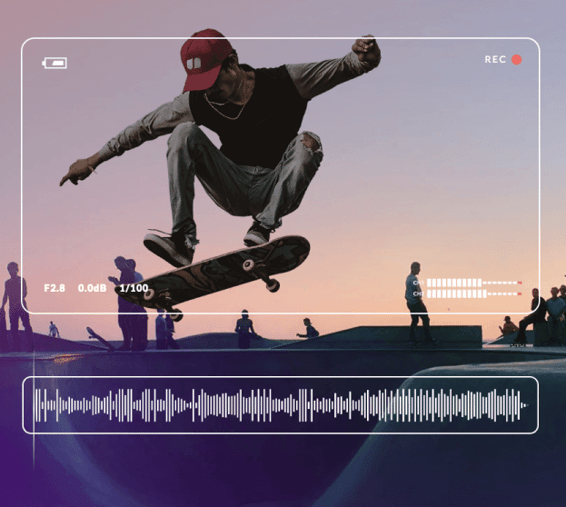Welcome to Outstanding
Royalty Free Instrumental Music






Listen to our Best Royalty Free Instrumental Music
We know the right song can make or break your project. That’s why every track in our library is vetted by award-winning producers. Hear for yourself. We've curated a playlist with our best royalty free instrumental music.
Looking for something different?
We got you. From classical to hip hop to indie, our audio library contains thousands of outstanding tracks. Use one of our 13 filters or check out other curated playlists to find what you need in minutes.
BROWSE THE FULL CATALOG
Dead Simple Licensing
Never worry about licensing again. With Soundstripe, your membership covers the cost for every song license. Just find the right track, download the file, and get a custom license. That’s it. No channel or media-specific fees, no recurring royalties, ever. Here’s more good news: you have unlimited licenses. Go ahead, download as many songs as you want.
Why Every Filmmaker Puts Their Trust In Royalty Free Instrumental Music
Visual storytelling isn’t just something you do by accident. It’s an artform, the culmination of a bunch of creative ideas and technical components coming together at once. And if you do it well, you can impact the emotions of any viewer — possibly even change their life.
Does that sound a little too over-the-top? That’s because I started listening to instrumental music before writing this, and the melodies sound like something you’d see in a SpaceX commercial.
The right song can draw that kind of romantic, quixotic reaction out of anyone. And because royalty free instrumental music has no LoFi beats or vocal tracks to distract you, you get to be fully immersed in the way the song makes you feel.
That is why instrumental music is so important for filmmakers. It’s not just a crutch for creating “the feels” — it’s the most reliable tool for layering emotions into something that is believable, organic, and powerful.
What Makes A Song “Instrumental”
So, right off the bat: “What the heck qualifies as royalty free instrumental music?”
We’ll get to the royalty free part later on. For now, let’s focus on making sense of this genre. It’s something we all know and enjoy on a regular basis, but we don’t always think about what makes it stand out from other kinds of music.
(More importantly, we also don’t think about how it can be used to improve our visual storytelling, but we’ll cover that later too.)
Probably the easiest way to think about instrumental music is “music that relies on instruments.” Which might sound like a redundant explanation, but when you think about how songs are filtered by genre, that particular qualification starts to make a little more sense.
At first glance, we assume “instruments” refers to traditional tools instead of electronic ones. It’s easy to think of a guitar or a saxophone or a tuba as part of instrumental music, while a drum machine belongs in EDM or hip hop music instead.
But the lines aren’t really that clear these days, unfortunately.
Part of composing music in a DAW program is using electronic samples — or, in other words, digital files that simulate instruments. These let someone compose or arrange music with a specific instrument (like a cello) without having to record someone playing the music.
This video gets a little complex, but it shows how a composer can write a song with nothing but digital instrument samples:
Music genres are weird and complicated, which is why most of them are more like loose guidelines than hard rules. And you would probably argue that most of your favorite soundtracks are instrumental music, although they often include a few electronic instruments.
That’s not even getting into contemporary instrumental music. Artists like Enya, Kenny G, Jim Brickman, and Yanni are all successful artists in this genre. Some of them combine traditional instrumentation with elements of electronic music, which basically segments an already complicated genre into even more particular (and confusing) subgenres.
You might think there would be disagreements from music experts about whether or not a song with electronic instrumentation counts as “instrumental.” But thanks to those DAW audio samples used by the vast majority of modern composers, there’s no clear cut line. And with no governing music authority, that gives us a bit of leeway too.
One thing that gets in the way of a simple definition is trying to pin down what actually constitutes as “instrumental” music. If you want a textbook summary, all a song has to do to fit into this genre is avoid using vocal tracks. And if there are vocals, they’ll be in the background like any other supporting instrument.
Now, that’s not the same as a guitar solo in a rock song. Any song can have an instrumental section, or “interlude,” but that doesn’t make it fit into the instrumental music bucket.
Here’s an easy way to remember it: If there are lyrics being sung or a thumping EDM beat, it’s not instrumental. This genre wants the listener to focus on how the instruments work together to create an emotion or feeling; things like lyrics and beats distract us from those smaller details.
So, in short, an instrumental song puts all of the listener’s focus on musical instruments. Sometimes traditional, sometimes electronic, and sometimes modulated vocal tracks.
How To Use Instrumental Music For Video
Instrumental music is a versatile tool for filmmakers. Since it’s all about a lack of distractions or over-the-top performances, you can easily use it in just about any project.
Here’s an example of a wedding film that uses instrumental music to perfectly balance the emotion and excitement of a couple’s big day:
And it’s not even a slow, classical-sounding video either. Again, the genre is versatile, and almost tailor-made to help accentuate the footage you’ve gotten.
You’ll also hear a lot of instrumental songs in corporate videos. In some cases, that will be music playing behind ads. It also includes those company training videos that we’ve all seen at one point or another.
Is it a trailer? A promotional video? An ad? This video can serve as all of those things, and the instrumental music builds up the emotion. There’s a sense of optimism and possibility, and that’s as much a credit to the song choice as to the footage used in this corporate video.
But if you don’t work for an ad agency or as a freelancer, you might wonder if instrumental music can work for your videos. You might be a vlogger, a social media filmmaker, or any other content creator who wants to improve their skills as a visual storyteller.
Yes, instrumental music can help.
Spend some time browsing on YouTube or Facebook and you’ll see that one of the most popular uses for instrumental music is in nature videos. It’s an easy way to add depth or emotion to a project, but it also won’t distract viewers from the amazing footage you’ve taken.
Whether you recorded snow-covered mountains, lush jungles, or some dusty ghost town, instrumental music is a tried-and-true way to show that off while building a specific tone or mood.
An added benefit for travel videos is that a lot of ethnic/international music is instrumental in nature, highlighting the unique instruments and music styles of that culture. (In some cases, even vocals can behave like another instrument if the words are in an unfamiliar language.)
Why Is Instrumental Music So Effective
There’s a reason this is the preferred music genre for studying, working, or any other kind of concentration-heavy task. And you can draw clear lines between how most people use these sorts of songs and what music does to different parts of the human brain.
We’ve all probably thought (at one point or another) that people who listen to classical music are pretentious, highly intelligent, or maybe even both. Kids who played in your school’s marching band were “band geeks” for a reason, right?
While scientists have proven that people who listen to instrumental music tend to be more intelligent, the reality is that our music choice doesn’t define our intelligence — it can actually improve it.
There is a lot of research being done in the neuroscience field to figure out how music affects the brain. (In fact, we wrote an entire post on that topic and how it should inform a filmmaker’s choice in music for videos.)
Music affects different parts of the brain in different ways, but perhaps the most interesting one is the limbic system (which controls emotional response).
According to research from Scientific American, music produces dopamine in the same amounts as exercise, good food, sex, and even drug use. That’s why music can feel so intimate, almost like a song can tap into our very identity and “speak” to us in a special way.
But music also affects the cerebrum, which is where our memories are stored. We all have strange mental associations between things, and sound is one of the biggest triggers.
It’s all too common for us to hear a song and be “transported” to another place or time in our lives. Music’s ability to activate so many different areas of the brain adds a lot of weight to the song choices that content creators make for their videos.
At the risk of sounding redundant: Instrumental music allows us to get the same benefits of listening to our favorite music, but it also frees us from paying attention to a guitar solo, a well-written chorus, or a complex arrangement.
That’s really the driving force behind why this genre exists, why it’s become so popular, and why so many content creators rely on it for their videos.
Where To Look For Royalty Free Instrumental Music
If you’ve ever looked up instrumental music, there’s a good chance you ended up on YouTube. The content there is kind of shuffled into one of two categories: 2-hour playlists from indie artists/composers or recent covers of popular songs.
Neither of those are bad or anything. But if you’re a content creator who wants good music for an upcoming project, neither of those options will work for you.
You can’t really drop a piano arrangement of “Watermelon Sugar” into a short film or corporate video, right? And not many of those longer compilation videos include the artist info for each song, which would make it difficult to track down and get permission to use a song you loved.
Finding instrumental music to listen to is easy. Finding instrumental music you can actually license for your own projects is much harder.
At least, it’s difficult if you try to do it all yourself. Your best option will be to look into royalty free instrumental music that you can use without having to worry about copyright infringement or DMCA claims.
When To Take Advantage of Royalty Free Music
Now that you’re at a point where you’re looking for music to use in your next project, the obvious answer is a Google search. But unfortunately, it’s hard to guarantee that you’re going to find music that matches the quality you’d want in background instrumental music.
Depending on what you search for, you could end up on a self-submit song library where anyone can upload their music as a free download. It might not cost you anything, but you’ll end up spending hours browsing the site in search of one song that actually sounds professional.
That’s where royalty free music sites have something of an advantage. Soundstripe employs professional musicians and Grammy-winning mix engineers, which means we’re confident that every one of our 5,000+ songs are radio-quality and something any director would be happy to use.
But using Soundstripe gives you more benefits than just audio quality. In addition to single-song purchases, we also offer a subscription program. By signing up for a subscription, you’ll get unlimited access to our entire library.
Yup, no more worrying about finding a useful song and buying a license for it. You can browse thousands of fantastic music, license as many tracks as you need, and rest assured knowing that your projects (and the song licenses) will be protected forever.
No hidden fees or obstacles. No complicated license negotiations. And of course, no royalty payments. You’ll get your subscription and walk right into a garden of royalty free instrumental music that could make the grumpiest viewer feel something when they watch your videos.
You’re also free to choose the plan and types of media you need most. With plans for sound effects, stock video, and royalty free music, you can mix and match to get the perfect blend for the kind of projects you work on. And all of that will be grouped into one easy-to-manage subscription.


Have questions? Give us a call
855.224.0847
Soundstripe - Unlimited Music for Video
© 2017-2020 A Product of Soundstripe, Inc
Nashville TN



